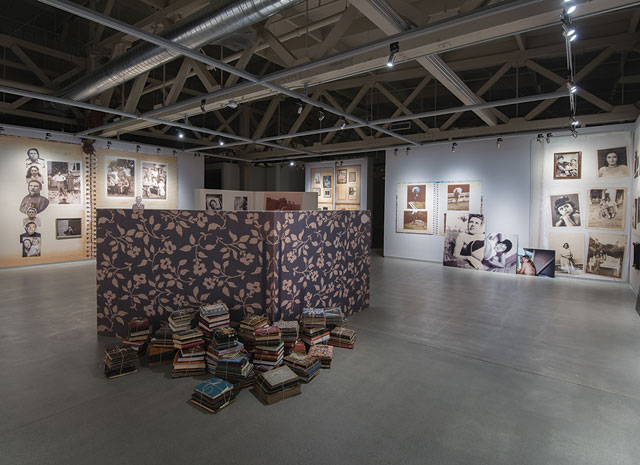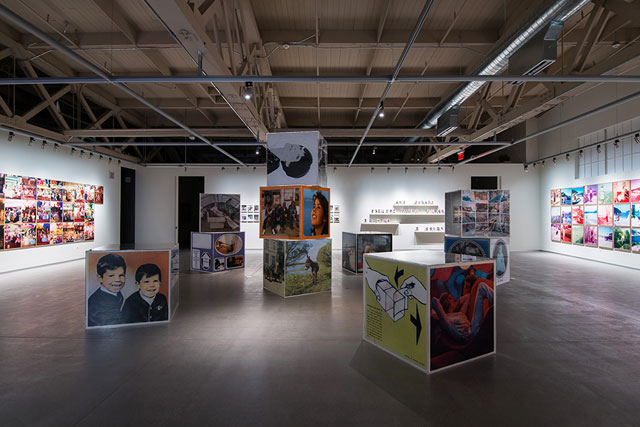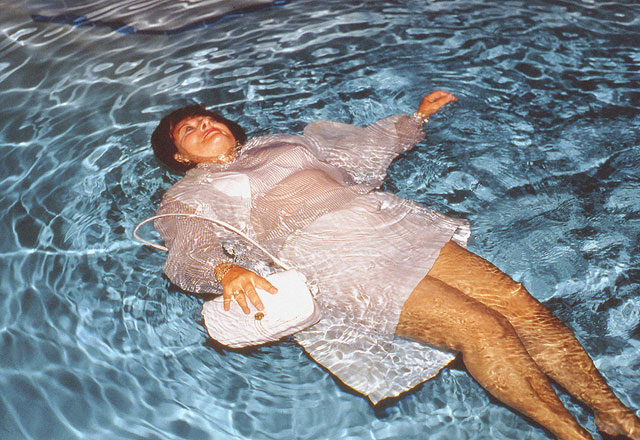Erik Kessels is looking at your photos. On your Flickr stream, on your blog, in your family album for sale at the flea market. He plucks them out of the growing mass of images, online and discarded, to discover the unusual beauty of flaws or the unique narratives that build over time through photographs. Kessels is a Dutch designer/curator/artist and the co-founder of communications agency KesselsKramer.
Pier24 Photography in San Francisco, one of the largest exhibition spaces for photography in the world, has dedicated three large galleries to Kessels’ explorations of appropriated imagery for the current exhibition, Secondhand.
In one room, a mass of 3×4-inch printed photographs extends from floor to ceiling. Thousands of photographs are piled on top of each other: images of flowers, family gatherings, sports events, landscapes, proms, pets. None are privileged, and the strewn-about quality beckons you to poke through them, which you can. This mountain is the physical manifestation of the magnitude of photographs collectively uploaded in a single day to the image sharing site Flickr. 24 Hours in Photos makes palpable the vigor with which we take and share photographs online. The experience is awe-inducing, unsettling, and at the same time it reveals something that we instinctively understand — there are abundant images online, most of them don’t matter, they are lost in the geological strata of Internet time. As 24 Hours in Photos is a representation of the contemporary condition of vernacular photography, Kessels’ other installation project, Album Beauty, is an antidote.

Album Beauty also monumentalizes snapshot photography. But here it’s the idiosyncratic manner in which family albums are constructed, from the collaged arrangements to the inclusions of “mistake” photographs, that is brought to our attention. For years Kessels has been collecting discarded family albums at flea markets and antique shops. For the installation, reproductions of individual photographs and full album pages are blown up and made sculptural. This has an Alice in Wonderland effect as the viewer moves through strangers’ memorialized lives, faded and flawed and colossal. Indeed, Album Beauty is itself a memorial; Kessels considers the installation to be a celebration of a now-defunct practice. Included in the installation are what appear to be dozens of original albums, stacked and wrapped in twine. The cord impedes the viewer from accessing the tactile quality of the images and the delight of flipping through pages to discover a beautifully strange, collaged composition or an accidental double exposure. We are given those quirky and surreal moments outright. This may be a bit troublesome to those familiar with the pleasures of the “hunt” for that ineffable something of a flea market treasure, but it does in fact correspond to the carefully curated connoisseurship of many photographic blogs.

In almost every picture is a third room of Kessels’ work, which contains highlights from his publishing project of the same name. For over ten years Kessels has been producing books of amateur photography through the publishing arm of his communications agency. He explained his process to me this way: “I’m almost like a detective going into these photographs and trying to find certain stories in them. And they might not always be 100% true, but when I put them together and without explaining too much of it, people also make their own stories out of it.” In the exhibition, we see what Kessels sees as he pours over endless images, looking for patterns and anomalies that can generate compelling narratives. Kessels’ editing is particularly successful here and the works are thoughtfully displayed. In the series, in almost every picture #3, large light boxes illuminate photographs — culled from a hunting website — of deer that have triggered their own portraits by motion sensors. The deer eyes glow from the flash bulb and the light boxes mimic the experience of looking at nature from a radiating computer screen.

In a particularly mesmerizing series presented as a slideshow video, in almost every picture #11, a woman is photographed throughout the years in different bodies of water — oceans, pools, bathtubs — always fully dressed. I asked Kessels to tell me about this particular project and how he came across the photographs. “I first found one image on Google… I was for some reason looking for somebody standing with their clothes on in water for something else, and I stumbled across this image… Fred is the photographer and Valerie is his wife, and they had a whole photo stream on Flickr. As I stayed in contact with them, I got to know the whole story. They had a wet-clothes adventures very frequently. For them, it’s a form of freedom… He, as a photographer, is a very good amateur, which I never mean [in a] negative [way], an amateur is someone who dares to make mistakes, and dares to take more and more risks, more than a professional.”
When I mentioned to Kessels that the in almost every picture publishing projects seemed to function as guides for how to stop and look at photographs, he quipped:
“Yeah, because we also live in an age where images become more and more important. Now we see more images before lunch than somebody in the 19th century would see in their whole life. It’s a different way of consuming images. But now that you see, for instance, that people have almost become editors. Everyday people, they have to become editors in what they would like to see and what they would not like to see, because it is such a bombardment of imagery coming at them. That’s an interesting thing — what kind of choices people make. For me it’s the same thing. The books are purely there to focus on a certain thing, highlight that and put a magnifying glass on that, so that people can view this just on its own.”
Secondhand runs through May 2015 at Pier 24 Photography in San Francisco. For more information and to make an appointment to see the exhibition, visit pier24.org.